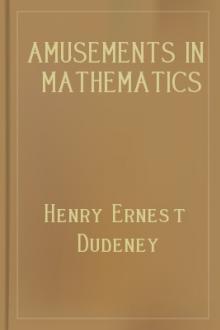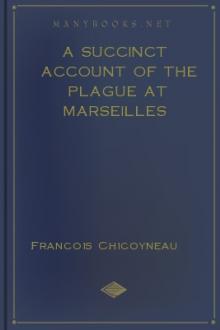Amusements in Mathematics, Henry Ernest Dudeney [books to read to be successful txt] 📗

- Author: Henry Ernest Dudeney
- Performer: 0486204731
Book online «Amusements in Mathematics, Henry Ernest Dudeney [books to read to be successful txt] 📗». Author Henry Ernest Dudeney
405.—CARD MAGIC SQUARES.—solution
Arrange the cards as follows for the three new squares:—
Three aces and one ten are not used. The summations of the four squares are thus: 9, 15, 18, and 27—all different, as required.
406.—THE EIGHTEEN DOMINOES.—solution

The illustration explains itself. It will be found that the pips in every column, row, and long diagonal add up 18, as required.
407.—TWO NEW MAGIC SQUARES.—solution
Here are two solutions that fulfil the conditions:—

The first, by subtracting, has a constant 8, and the associated pairs all have a difference of 4. The second square, by dividing, has a constant 9, and all the associated pairs produce 3 by division. These are two remarkable and instructive squares.
408.—MAGIC SQUARES OF TWO DEGREES.—solution
The following is the square that I constructed. As it stands the constant is 260. If for every number you substitute, in its allotted place, its square, then the constant will be 11,180. Readers can write out for themselves the second degree square.

The main key to the solution is the pretty law that if eight numbers sum to 260 and their squares to 11,180, then the same will happen in the case of the eight numbers that are complementary to 65. Thus 1 + 18 + 23 + 26 + 31 + 48 + 56 + 57 = 260, and the sum of their squares is 11,180. Therefore 64 + 47 + 42 + 39 + 34 + 17 + 9 + 8 (obtained by subtracting each of the above numbers from 65) will sum to 260 and their squares to 11,180. Note that in every one of the sixteen smaller squares the two diagonals sum to 65. There are four columns and four rows with their complementary columns and rows. Let us pick out the numbers found in the 2nd, 1st, 4th, and 3rd rows and arrange them thus :—
Here each column contains four consecutive numbers cyclically arranged, four running in one direction and four in the other. The numbers in the 2nd, 5th, 3rd, and 8th columns of the square may be similarly grouped. The great difficulty lies in discovering the conditions governing these groups of numbers, the pairing of the complementaries in the squares of four and the formation of the diagonals. But when a correct solution is shown, as above, it discloses all the more important keys to the mystery. I am inclined to think this square of two degrees the most elegant thing that exists in magics. I believe such a magic square cannot be constructed in the case of any order lower than 8.
409.—THE BASKETS OF PLUMS.—solution
As the merchant told his man to distribute the contents of one of the baskets of plums "among some children," it would not be permissible to give the complete basketful to one child; and as it was also directed that the man was to give "plums to every child, so that each should receive an equal number," it would also not be allowed to select just as many children as there were plums in a basket and give each child a single plum. Consequently, if the number of plums in every basket was a prime number, then the man would be correct in saying that the proposed distribution was quite impossible. Our puzzle, therefore, resolves itself into forming a magic square with nine different prime numbers.

In Diagram A we have a magic square in prime numbers, and it is the one giving the smallest constant sum that is possible. As to the little trap I mentioned, it is clear that Diagram A is barred out by the words "every basket contained plums," for one plum is not plums. And as we were referred to the baskets, "as shown in the illustration," it is perfectly evident, without actually attempting to count the plums, that there are at any rate more than 7 plums in every basket. Therefore C is also, strictly speaking, barred. Numbers over 20 and under, say, 250 would certainly come well within the range of possibility, and a large number of arrangements would come within these limits. Diagram B is one of them. Of course we can allow for the false bottoms that are so frequently used in the baskets of fruitsellers to make the basket appear to contain more fruit than it really does.
Several correspondents assumed (on what grounds I cannot think) that in the case of this problem the numbers cannot be in consecutive arithmetical progression, so I give Diagram D to show that they were mistaken. The numbers are 199, 409, 619, 829, 1,039, 1,249, 1,459, 1,669, and 1,879—all primes with a common difference of 210.
410.—THE MANDARIN'S "T" PUZZLE.—solution
There are many different ways of arranging the numbers, and either the 2 or the 3 may be omitted from the "T" enclosure. The arrangement that I give is a "nasik" square. Out of the total of 28,800 nasik squares of the fifth order this is the only one (with its one reflection) that fulfils the "T" condition. This puzzle was suggested to me by Dr. C. Planck.

411.—A MAGIC SQUARE OF COMPOSITES.—solution
The problem really amounts to finding the smallest prime such that the next higher prime shall exceed it by 10 at least. If we write out a little list of primes, we shall not need to exceed 150 to discover what we require, for after 113 the next prime is 127. We can then form the square in the diagram, where every number is composite. This is the solution in the smallest numbers. We thus see that the answer is arrived at quite easily, in a square of the third order, by trial. But I propose to show how we may get an answer (not, it is true, the one in smallest numbers) without any tables or trials, but in a very direct and rapid manner.

First write down any consecutive numbers, the smallest being greater than 1—say, 2, 3, 4, 5, 6, 7, 8, 9, 10. The only factors in these numbers are 2, 3, 5, and 7. We therefore multiply these four numbers together and add the product, 210, to each of the nine numbers. The result is the nine consecutive composite numbers, 212 to 220 inclusive, with which we can form the required square. Every number will necessarily be divisible by its difference from 210. It will be very obvious that by this method we may find as many consecutive composites as ever we please. Suppose, for example, we wish to form a magic square of sixteen such numbers; then the numbers 2 to 17 contain the factors 2, 3, 5, 7, 11, 13, and 17, which, multiplied together, make 510510 to be added to produce the sixteen numbers 510512 to 510527 inclusive, all of which are composite as before.
But, as I have said, these are not the answers in the smallest numbers: for if we add 523 to the numbers 1 to 16, we get sixteen consecutive composites; and if we add 1,327 to the numbers 1 to 25, we get twenty-five consecutive composites, in each case the smallest numbers possible. Yet if we required to form a magic square of a hundred such numbers, we should find it a big task by means of tables, though by the process I have shown it is quite a simple matter. Even to find thirty-six such numbers you will search the tables up to 10,000 without success, and the difficulty increases in an accelerating ratio with each square of a larger order.
412.—THE MAGIC KNIGHT'S TOUR.—solution

Here each successive number (in numerical order) is a knight's move from the preceding number, and as 64 is a knight's move from 1, the tour is "re-entrant." All the columns and rows add up 260. Unfortunately, it is not a perfect magic square, because the diagonals are incorrect, one adding up 264 and the other 256—requiring only the transfer of 4 from one diagonal to the other. I think this is the best result that has ever been obtained (either re-entrant or not), and nobody can yet say whether a perfect solution is possible or impossible.
413.—A CHESSBOARD FALLACY.—solution

The explanation of this little fallacy is as follows. The error lies in assuming that the little triangular piece, marked C, is exactly the same height as one of the little squares of the board. As a matter of fact, its height (if we make the sixty-four squares each a square inch) will be 11/7 in. Consequently the rectangle is really 91/7 in. by 7 in., so that the area is sixty-four square inches in either case. Now, although the pieces do fit together exactly to form the perfect rectangle, yet the directions of the horizontal lines in the pieces will not coincide. The new diagram above will make everything quite clear to the reader.
414.—WHO WAS FIRST?—solution
Biggs, who saw the smoke, would be first; Carpenter, who saw the bullet strike the water, would be second; and Anderson, who heard the report, would be last of all.
415.—A WONDERFUL VILLAGE.—solution
When the sun is in the horizon of any place (whether in Japan or elsewhere), he is the length of half the earth's diameter more distant from that place than in his meridian at noon. As the earth's semi-diameter is nearly 4,000 miles, the sun must be considerably more than 3,000 miles nearer at noon than at his rising, there being no valley even the hundredth part of 1,000 miles deep.
416.—A CALENDAR PUZZLE.—solution
The first day of a century can never fall on a Sunday; nor on a Wednesday or a Friday.
417.—THE TIRING IRONS.—solution
I will give my complete working of the solution, so that readers may see how easy it is when you know how to proceed. And first of all, as there is an even number of rings, I will say that they may all be taken off in one-third of (2(n + 1) - 2) moves; and since n in our case is 14, all the rings may be taken off in 10,922 moves. Then I say 10,922 - 9,999 = 923, and proceed to find the position when only 923 out of the 10,922 moves remain to be made. Here is the curious method of doing this. It is based on the binary scale method used by Monsieur L. Gros, for an account of which see W.W. Rouse Ball's Mathematical Recreations.
Divide 923 by 2, and we get 461 and the remainder 1; divide 461 by 2, and we get 230 and the remainder 1; divide 230 by 2, and we get 115 and the remainder nought. Keep on dividing by 2 in this way as long as possible, and all the remainders will be found to be 1, 1, 1, 0, 0, 1, 1, 0, 1, 1, the last remainder being to the left and the first remainder to the





Comments (0)